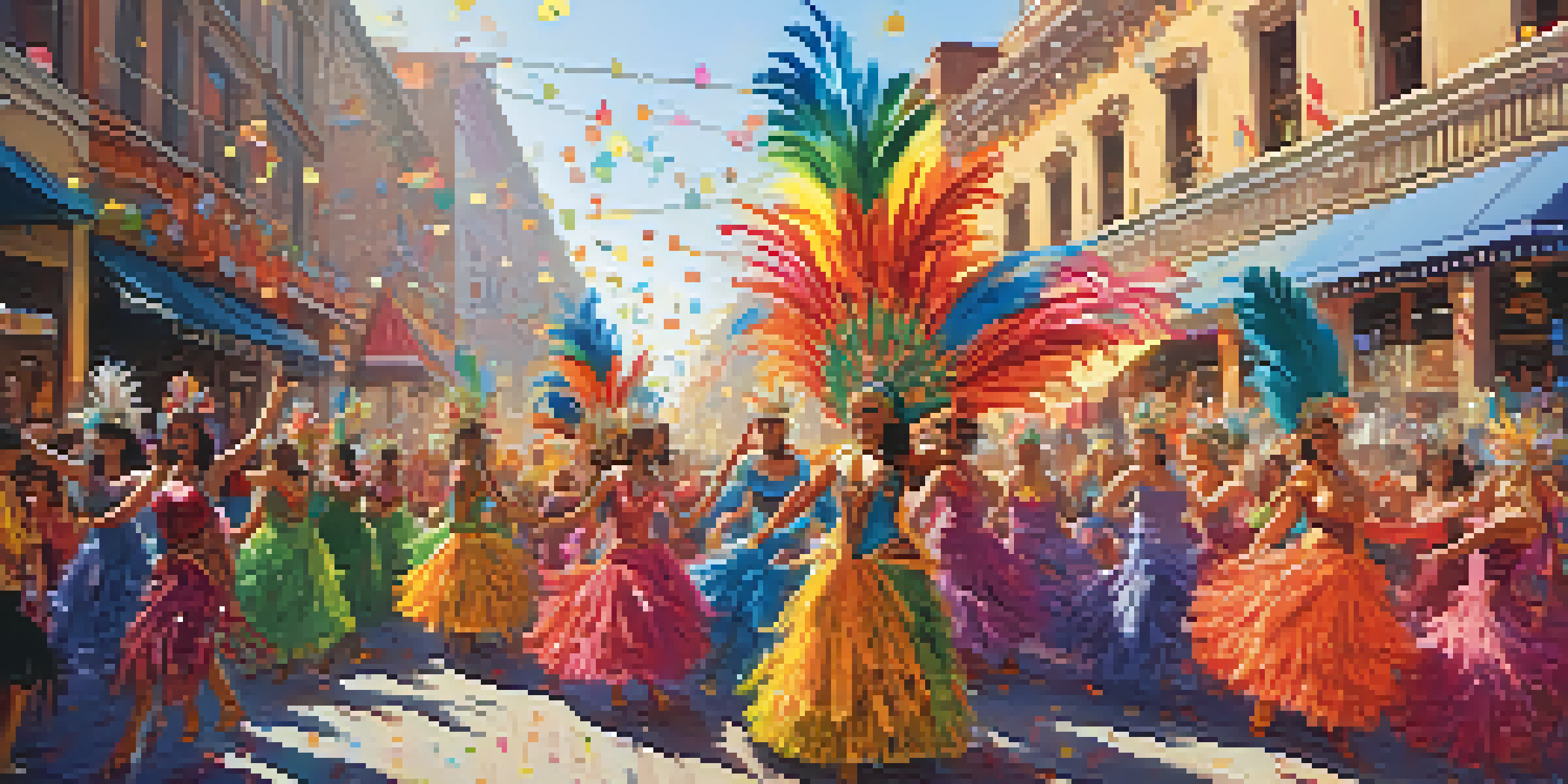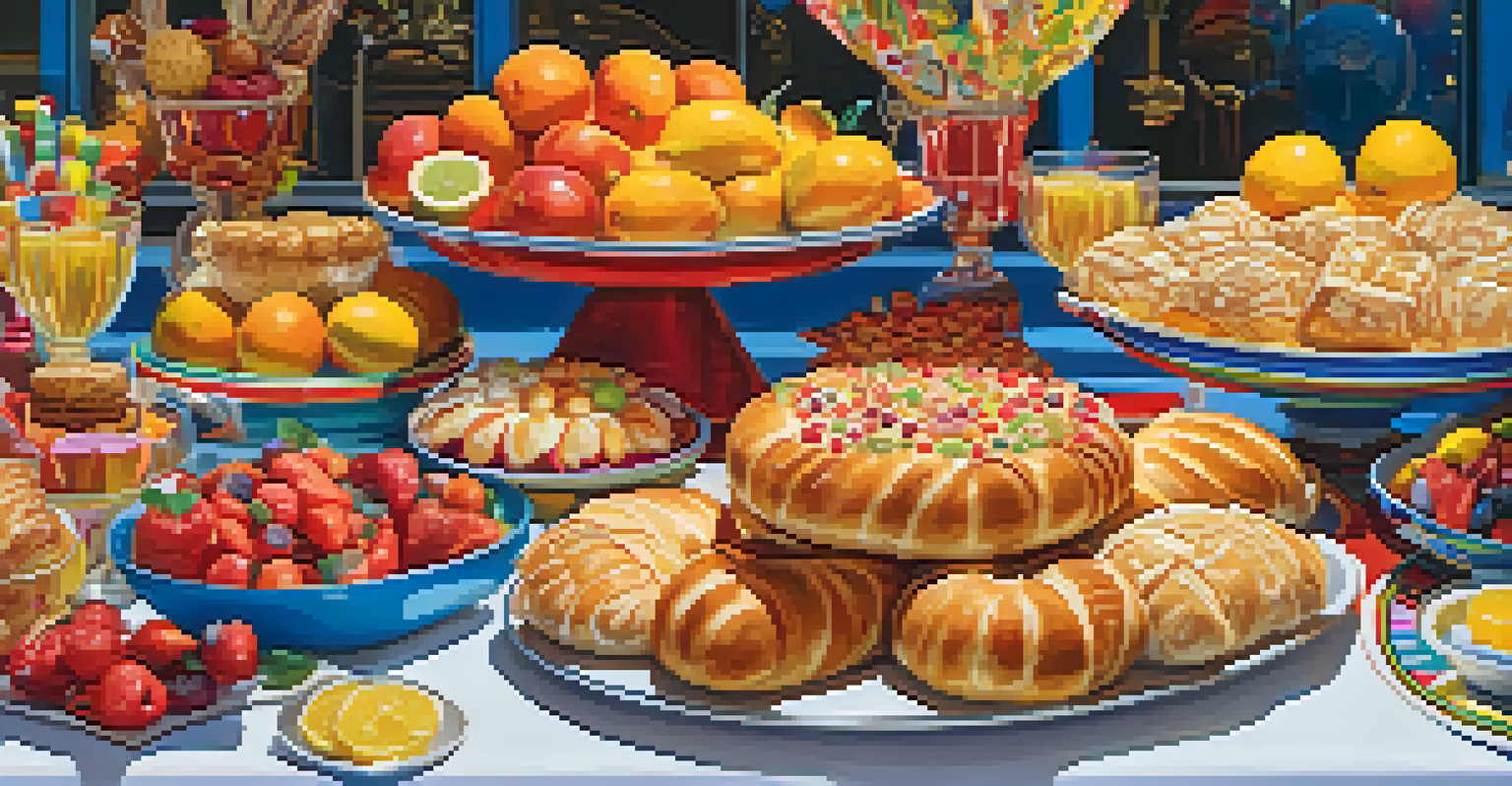The Evolution of Carnival: From Tradition to Modern Spectacle

Understanding the Origins of Carnival Celebrations
Carnival has deep historical roots, tracing back to ancient festivals celebrating the arrival of spring. These early gatherings were often marked by feasting, dancing, and a sense of communal joy. Over time, different cultures added their unique flavors, creating a rich tapestry of traditions that would evolve into the Carnivals we know today.
Carnival is a time when the world is turned upside down, a time when the normal rules of society are suspended and the extraordinary is celebrated.
In many places, Carnival is linked to religious observances, particularly in Christian traditions. Before the solemnity of Lent, communities would engage in merrymaking, indulging in food and festivities. This aspect of Carnival reflects a universal human desire to celebrate life, even in the face of upcoming challenges.
As these traditions spread across the globe, they were influenced by local customs and practices. From the vibrant parades of Brazil to the masked balls in Venice, each region has developed its own distinctive style of celebration, showcasing the diversity and richness of human culture.
The Transformation of Carnival Through the Ages
As societies evolved, so did the celebrations of Carnival. The Renaissance period marked a significant turning point, where art and performance became integral to the festivities. This era introduced elaborate costumes and theatrical elements, setting the stage for the grand spectacles we see today.

The 19th and 20th centuries brought further changes, with industrialization and urbanization influencing how Carnival was celebrated. Cities became the focal points for large-scale parades, drawing crowds and fostering a sense of community. This shift also meant that Carnival began to attract more tourists, leading to a blend of local traditions with global influences.
Carnival's Rich Historical Roots
Carnival celebrations originate from ancient festivals that evolved through cultural influences, reflecting a universal desire to celebrate life.
Today, Carnival is often seen as a major tourist attraction, showcasing the artistic talents of communities while also serving as a platform for social and political expression. This evolution reflects not just a change in how Carnival is celebrated, but also what it represents to different cultures around the world.
Key Elements of Traditional Carnival Celebrations
At the heart of traditional Carnival celebrations are music, dance, and vibrant costumes. Each of these elements plays a crucial role in creating an atmosphere of joy and exuberance. For instance, the infectious rhythms of samba in Brazil invite everyone to join in the dance, creating a sense of unity among participants.
Festivals are the heartbeats of communities, reminding us of our shared culture and history.
Food also holds a significant place in Carnival traditions, often reflecting the cultural heritage of the region. From mouthwatering street foods to elaborate feasts, culinary delights serve as a way to bring people together, enhancing the communal experience. This connection between food and celebration is a universal theme in many Carnival festivities.
Additionally, the use of masks and costumes adds an element of mystery and creativity to Carnival. These disguises allow individuals to express themselves freely, breaking down social barriers. It's a time when everyone can become part of the spectacle, reinforcing the idea that Carnival is for all.
Modern Carnival: The Influence of Technology
In recent years, technology has profoundly impacted how Carnival is celebrated. Social media platforms have become vital tools for promoting events, sharing experiences, and connecting with a global audience. This digital presence has helped to elevate Carnival from local festivities to worldwide celebrations.
Moreover, technology has changed the way parades and performances are produced. With advanced lighting, sound systems, and digital displays, organizers can create more immersive experiences for participants and spectators alike. This integration of technology allows for creativity to flourish, enhancing the visual spectacle of Carnival.
Cultural Expression Through Carnival
Carnival serves as a vital platform for showcasing cultural heritage and addressing social issues, blending celebration with activism.
However, this modernization raises questions about authenticity and the preservation of traditional practices. While technology can enhance the experience, it's essential to strike a balance that honors the origins of Carnival while embracing innovation. This ongoing dialogue is crucial for the future of these cherished celebrations.
Carnival as a Form of Cultural Expression
Carnival serves as a powerful platform for cultural expression, allowing communities to showcase their heritage and identity. Through music, dance, and storytelling, participants can share their unique narratives, fostering a sense of pride and belonging. This cultural representation is especially important in multicultural societies, where diverse voices can shine.
Moreover, Carnival often provides a space for social commentary and political expression. Artists and performers use the festivities to address pressing issues, challenge norms, and promote awareness. This blend of celebration and activism reflects the dynamic nature of Carnival, as it evolves to meet the needs of society.
The ability to engage in dialogue through art and performance during Carnival is what makes these celebrations so impactful. They not only entertain but also educate and inspire, creating a rich tapestry of cultural narratives that resonate with people across generations.
Global Variations of Carnival Around the World
While Carnival has common threads that link its various forms, the celebrations differ significantly from one region to another. For instance, the Carnaval in Rio de Janeiro is famous for its elaborate parades and samba schools, while Mardi Gras in New Orleans is known for its vibrant beads and lively street parties. Each location adds its unique spin, making Carnival a truly global phenomenon.
In Europe, cities like Venice celebrate with masked balls that hark back to the Renaissance, emphasizing elegance and mystery. The contrast between these styles highlights how local customs and historical influences shape the way Carnival is experienced across cultures. Each celebration tells a story, reflecting the values and traditions of its community.
Modern Challenges and Innovations
As Carnival faces globalization and environmental challenges, communities have opportunities to innovate while preserving their traditions.
These global variations enrich the overall Carnival experience, allowing people to explore different cultural expressions. Whether it's the energy of a Caribbean festival or the sophistication of a European celebration, each Carnival offers a unique glimpse into the diverse ways humanity celebrates life.
The Future of Carnival: Challenges and Opportunities
As Carnival continues to evolve, it faces both challenges and opportunities in the modern world. Globalization and commercialization can sometimes dilute the authenticity of these celebrations, leading to concerns about cultural appropriation. It's essential for communities to find ways to celebrate their traditions genuinely while adapting to changing times.
Additionally, the impact of climate change poses significant challenges to outdoor celebrations. Communities must consider sustainability and environmental responsibility in their planning to ensure that Carnival can continue for future generations. This shift toward eco-friendly practices is an opportunity for innovation and creativity in how Carnival is celebrated.

Ultimately, the future of Carnival lies in its ability to adapt while remaining true to its roots. By embracing change and nurturing cultural heritage, Carnival can continue to thrive as a vibrant expression of community and identity, bringing people together in celebration for years to come.